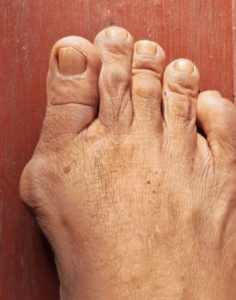Swelling and pain on the side of your big toe can be caused by a variety of conditions, such as bunions, gout, or an ingrown toenail. No matter the cause, managing the swelling and discomfort at home can make a big difference while you wait for professional care. Here’s what you can do:
1. Rest and Elevation
One of the first things to do is to give your foot plenty of rest. Avoid standing or walking for extended periods, and limit any activities that put stress on the toe, like running or heavy lifting. When possible, elevate your foot by propping it up on pillows. Elevating your foot helps reduce swelling by allowing fluids to drain away from the affected area. Try to keep your foot raised above the level of your heart for optimal results.
2. Cold Compress
Applying a cold compress to the swollen area can help reduce inflammation and numb the pain. Use a clean cloth to wrap ice or a cold pack and apply it gently to the swollen part of your big toe for 15-20 minutes at a time, several times a day. Be careful not to apply the ice directly to your skin, as it could cause frostbite. If you don’t have a cold pack, frozen peas or a bag of frozen corn works as an effective alternative.
3. Over-the-Counter Pain Relief
If the pain is bothering you, non-steroidal anti-inflammatory drugs (NSAIDs) like ibuprofen (Advil, Motrin) or naproxen (Aleve) can help reduce both pain and swelling. Be sure to follow the dosage instructions on the label and consult with a healthcare provider if you’re unsure about taking these medications, especially if you have any underlying health conditions.
4. Foot Soaks
Soaking your foot in warm water can help alleviate discomfort. Add Epsom salt to the water, as it may help reduce swelling and relieve pain. Soak your foot for about 15-20 minutes, then dry it gently with a clean towel. If the swelling is significant, avoid hot water, as it can increase swelling. Also, make sure to not soak your foot if there’s any open wound or infection, as it could exacerbate the problem.
5. Proper Footwear
Wearing the right shoes is crucial while you’re managing this issue at home. Tight, ill-fitting shoes or high heels can make swelling and pain worse. Opt for comfortable, supportive shoes with a wide toe box to avoid putting extra pressure on your big toe. Avoid sandals or flip-flops that don’t offer enough support, and try cushioned insoles for added comfort.
6. Gentle Massage
If there’s no significant injury and you feel comfortable doing so, gently massaging the swollen area can help promote circulation and reduce tension. Use a moisturizing lotion or oil to help your hands glide smoothly over the skin, and apply light pressure. Avoid aggressive massaging, as it could worsen the swelling or pain.
7. Monitor for Red Flags
While you manage the swelling at home, keep an eye out for any signs that might require immediate medical attention. If the swelling worsens, you notice redness or warmth around the toe, or if you develop fever or an open wound, it’s important to seek medical help promptly. These symptoms could indicate an infection or other serious condition that needs professional care.
